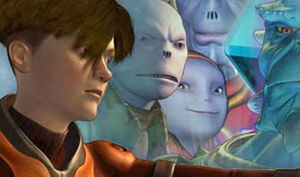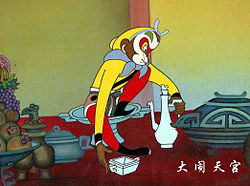- Chinese animation
-
Chinese animation (simplified Chinese: 华人制动画; traditional Chinese: 華人製動畫; pinyin: Huárénzhì dònghuà) or Manhua Anime, in narrow sense, refers to animations that are made in China. In broad sense, it may refers to animations that are made in any Chinese speaking countries such as People's Republic of China (mainland China), Republic of China (Taiwan), Hong Kong, Singapore, Malaysia, etc.
Contents
History
Main article: History of Chinese animationThe history of Chinese animation began in 1918 when an animation piece from the US titled Out of the Inkwell landed in Shanghai. Cartoon clips were first used in advertisements for domestic products. Though the animation industry did not begin until the arrival of the Wan brothers in 1926. From the first film with sound The Camel's Dance to the first film of notable length Princess Iron Fan, China was relatively on pace with the rest of the world. Though China's golden age of animation would come to a complete halt when the Chinese Communist Party led by Mao Zedong introduced the Cultural Revolution.[1] Many animators were forced to quit. If not for harsh economic conditions, the mistreatment of the Red Guards would threaten their work. The surviving animations would lean closer to propaganda. By the 1980s, Japan would emerge as the animation powerhouse of the Far East, leaving China's industry decimated in reputation and productivity. Though two major changes would occur in the 1990s, igniting some of the biggest changes since the exploration periods. The first is a political change. The implementation of a socialist market economy would push out traditional planned economy systems.[2] No longer would a single entity limit the industry's output and income. The second is a technological change with the arrival of the Internet. New opportunities would emerge from flash animations and the contents became more open. Today China is drastically reinventing itself in the animation industry with greater influences from Hong Kong and Taiwan.
Terminology
Chinese animations today can best be described in two categories. The first type are "Conventional Animations" produced by corporations of well-financed entities. These content falls along the lines of traditional 2D cartoons or modern 3D CG animated films distributed via cinemas, DVD or broadcasted on TV. This format can be summarized as a reviving industry coming together with advanced computer technology and low cost labor.[3]
The second type are "Webtoons" produced by corporations or sometimes just individuals. These contents are generally flash animations ranging anywhere from amateurish to high quality, hosted publicly on various websites. While the global community has always gauged industry success by box office sales. This format cannot be denied when measured in hits among a population of 1.3 billion in just mainland China alone. Most importantly it provides greater freedom of expression on top of potential advertising.
Characteristics
In the 1920s, the pioneering Wan brothers believed that animations should emphasize on a development style that was uniquely Chinese. This rigid philosophy stayed with the industry for decades. And animations were essentially an extension of other facets of Chinese arts and culture, drawing more contents from ancient folkores and manhua. An example of a traditional Chinese animation character would be Monkey King, a character transitioned from the classic literature Journey to the West to the 1964 animation Havoc in Heaven. Though the concept of Chinese animations have begun loosening up in recent years without locking into any particular one style. One of the first revolutionary change was in the 1995 manhua animation adaptation Cyber Weapon Z. The style consist of characters that are practically indistinguishable from any typical anime, yet it is categorized as Chinese animation. It can be said that productions are not necessarily limited to any one technique; that water ink, puppetry, computer CG are all demonstrated in the art.
Newer waves of animations since the 1990s, especially flash animations, are trying to break away from the tradition. In 2001 Time Magazine Asia Edition would rate the Taiwanese webtoon character A-kuei as one of the top 100 new figures in Asia.[4] The appearance of A-kuei with the large head, would probably lean much closer to children's material like Doraemon. So changes like this signify a welcoming transition, since folklore-like characters have always had a hard time gaining international appeal. GoGo Top magazine, the first weekly Chinese animation magazine, conducted a survey and proved that only 1 out of 20 favorite characters among children was actually created domestically in China.[5]
Conventional animation market
 Animation from mainland China Thru the Moebius Strip
Animation from mainland China Thru the Moebius Strip
 Hong Kong Chinese Animation, Cyber Weapon Z
Hong Kong Chinese Animation, Cyber Weapon Z
From the demographics perspective, the Chinese consumer market has identified 11% of the audience are under the age of 13 with 59% between 14 to 17 and 30% over 18 years of age. Potentially 500 million people could be identified as cartoon consumers.[6] China has 370 million children, one of the world’s largest animation audiences.[7]
From the financial perspective, Quatech Market Research surveyed ages between 14 to 30 in Beijing, Shanghai and Guangzhou and found that over 1.3 billion RMB (about US $163 million) was spent on cartoons every year, but more than 80% of the revenue flows straight out of the country. Further studies show that 60% still prefer Japanese anime, 29% prefer Americans, and just 11 percent favor those made by Chinese mainland, Taiwan or Hong Kong animators.
In 1999 Shanghai Animation Film Studio spent 21 million RMB (about US $2.6 million) producing the animation Lotus Lantern. The film earned a box office income of more than RMB 20 million (about US $2.5 million), but failed to capitalize on any related products. The same company shot a cartoon series Music Up in 2001, and although 66% of its profits came from selling related merchandise, it lagged far behind foreign animations.[8]
2007 saw the debut of the popular Chinese Series, Qin's Moon. It boasted impressive 3d graphics and an immersive storyline. Its third season was released on June 23, 2010. Its fourth season is under production.
One of the most popular manhua in Hong Kong was Old Master Q. The characters were converted into cartoon forms as early as 1981, followed by numerous animation adaptations including a widescreen DVD release in 2003. While the publications remained legendary for decades, the animations have always been considered more of a fan tribute. And this is another sign that newer generations are further disconnected with older styled characters. Newer animations like My Life as McDull has also been introduced to expand on the modern trend.In 2005 the first 3D CG-animated movie from Shenzhen China, Thru the Moebius Strip was debuted. Running for 80 minutes, it is the first 3D movie fully rendered in mainland China to premiere in the Cannes Film Festival.[9] It was a critical first step for the industry.
In November 2006 an animation summit forum was held to announce China's top 10 most popular domestic cartoons as Century Sonny, Tortoise Hanba's Stories, Black Cat Detective, SkyEye, Lao Mountain Taoist, Nezha Conquers the Dragon King, Wanderings of Sanmao, Zhang Ga the Soldier Boy, The Blue Mouse and the Big-Faced Cat and 3000 Whys of Blue Cat.[10] Century Sonny is a 3D CG-animated TV series with 104 episodes fully rendered.
Flash animation market
On September 15, 1999 FlashEmpire became the first flash community in China to come online. While it began with amateurish contents, it was one of the first time any form of user-generated contents was offered in the mainland. By the beginning of 2000, it averaged 10,000 hits daily with more than 5,000 individual work published. Today it has more than 1 million members.[11]
In 2001, Xiao Xiao, a series of flash animations about kung fu stick figures became an Internet phenomenon totaling more than 50 million hits, most of which in mainland China. It also became popular overseas with numerous international artists borrowing the Xiao Xiao character for their own flash work in sites like Newgrounds.
On April 24, 2006 Flashlands.com was launched, hosting a variety of high quality flash animations from mainland China. The site is designed to be one of the first cross-cultural site allowing English speakers easy access to domestic productions. Though the success of the site has yet to be determined.
In October 2006, 3G.NET.CN paid 3 million RMB (about US$ 380,000) to produce A Chinese odyssey, the flash version of Stephen Chow's A Chinese Odyssey in flash format.[12][dead link]
Criticism
Statistics from China's State Administration of Radio, Film and Television (SARFT) indicate domestic cartoons aired 1hr 30 minutes each day from 1993 to 2002. And that by the end of 2004, it increased the airing time of domestic cartoons to 2hrs per day.[13] The division requested a total of 2,000 provinces to devote a show time of 60,000 minutes to domestically-produced animations and comic works. But statistics show that domestic animators can only provide enough work for 20,000 minutes, leaving a gap of 40,000 minutes that can only be filled by foreign programs. Though insiders are criticizing domestic cartoons for its emphasis on education over entertainment.[14]
SARFT also have a history of taking protectionism actions such as banning foreign shows like Babe: Pig in the City. While statistics are proving there are not enough domestic materials available[citation needed], the administration continues to ban foreign materials. On February 15, 2006 another notice is issued to ban cartoons that incorporated live actors. As reported by Xinhua News Agency, the commission did not want CGI and 2D characters alongside human actors.[citation needed] Doing so would jeopardize the broadcast order of homemade animation and mislead their development. Both bans do not make logical sense to the general public.[15][16]
See also
- Qin's Moon
- List of Chinese animated films
- History of animation
- History of Chinese animation
- Chinese art
- List of animated feature films
- Manhua
References
- ^ Qing Yun. "Qing Yun." Qing Yun.com. Retrieved on 2006-12-19.
- ^ Socialist Marketing Economy. "Socialist Marketing Economy." "Socialist Marketing Economy." Retrieved on 2006-12-20.
- ^ New York Times December 2004. "NY Times." "China Hurries to Animate Its Film Industry." Retrieved on 2006-12-20.
- ^ A-Kuei from Time magazine. "Time Magazine." Akuei in Time Magazine. Retrieved on 2006-12-19.
- ^ China Today. "China Today." "Chinese Animation Market: Monkey King vs Mickey Mouse." Retrieved on 2006-12-20.
- ^ Homepage of author Jonathan Clement. "Homepage of author Jonathan Clement. " "Chinese Animation." Retrieved on 2006-12-21.
- ^ People's Daily Online. "People's Daily Online." "China Opens Cartoon Industry to Private Investors." Retrieved on 2006-12-20.
- ^ China Today. "China Today." "Chinese Animation Market: Monkey King vs Mickey Mouse." Retrieved on 2006-12-20.
- ^ Broadcast Buyers Guide. "Broadcast Buyers Guide." "GDC Technology and Arts Alliance Media Partner for a Digital Screening Premiere at Cannes." Retrieved on 2006-12-21.
- ^ China's CityLife. "China's City Life." "Top 10 Domestic Cartoons." Retrieved on 2006-12-21.
- ^ FlashEmpire. "FlashEmpire. " "FlashEmpire info." Retrieved on 2006-12-19.
- ^ Embedded Flash Advertising. "Virtual China Org." "Embedded Flash Advertising." Retrieved on 2006-12-21.
- ^ People's Daily Online. "People's Daily Online." "Cartoon Festival Launches Monkey King Award." Retrieved on 2006-12-20.
- ^ People's Daily Online. "People's Daily Online." "China Opens Cartoon Industry to Private Investors." Retrieved on 2006-12-20.
- ^ USA Today. "Usatoday." "Animation Ban." Retrieved on 2006-12-20.
- ^ BackStageCasting. "BackStageCasting." "China bans TV toons that include live actors." Retrieved on 2006-12-20.
External links
- China's Cartoon Industry Forum
- Remembering Te Wei at AnimationInsider.net
Cinema of China 
Animation topics By country China · India · Japan · Korea · Philippines · United States
Azerbaijan · Canada · China · France · Iran · Japan · Russia · United Kingdom · United States
Industry Animator (List of animators) · Animation director · Animation studios · biologist simulateurs · Animation film festivals (international / regional)
Works Feature-length films · Short films · Television series (1900s) (2000s) · Films based on animated cartoons · Computer-animated films · Stop-motion films
Techniques Clay (strata-cut) · Cutout (silhouette) · Graphic · Model (go motion) · Object · Pixilation · Puppetoon
Flash · PowerPoint · SVG
Other methodsDrawn-on-film · Flip book · Inbetweening · Paint-on-glass · Pinscreen · Pixel art · Pose to pose · Sand
Related topics Cartoon series · Cartoon physics · Animated cartoon · Character animation · Independent animation · Adult animation · List of animated shorts available on DVD
Categories:- Chinese animation
- Chinese art
- Arts in China
Wikimedia Foundation. 2010.


